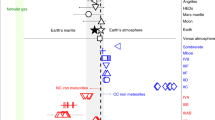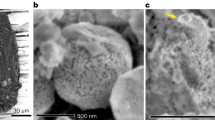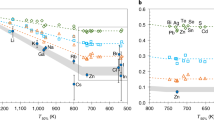Abstract
Terrestrial nitrogen isotopic compositions are distinct from solar and cometary values and similar to those of primitive meteorites, suggesting that Earth’s atmospheric nitrogen originates from a primordial cosmochemical source1,2. Prebiotic organic compounds containing nitrogen that formed in the solar protoplanetary disk, such as amino acids, may have contributed to the emergence of life on Earth3,4. However, the original reservoirs of these volatile compounds and the processes involved in their distribution and chemical modification before accretion remain unclear. Here we report the occurrence of the mineral carlsbergite (chromium nitride) within nanocrystalline sulphide inclusions of primitive chondritic meteorites using transmission electron microscopy and secondary ion mass spectrometry. The characteristics and occurrence of carlsbergite are consistent with precipitation from a chromium-bearing metal in the presence of reactive ammonia. The carlsbergite crystals have nitrogen isotopic compositions that differ from ammonia in cometary ices, but are similar to Earth’s atmospheric nitrogen. We suggest that the reactive ammonia proposed to have initiated formation of the carlsbergite came from ices within regions of the protoplanetary disk that were affected by the distal wakes of shock waves. Our findings imply that these primordial ammonia-bearing ices were a nitrogen reservoir within the formation region of the chondritic meteorite parent bodies and could have been a source of volatiles for the early Earth.
This is a preview of subscription content, access via your institution
Access options
Subscribe to this journal
Receive 12 print issues and online access
$259.00 per year
only $21.58 per issue
Buy this article
- Purchase on Springer Link
- Instant access to full article PDF
Prices may be subject to local taxes which are calculated during checkout




Similar content being viewed by others
References
Marty, B. The origins and concentrations of water, carbon, nitrogen and noble gases on Earth. Earth Planet. Sci. Lett. 313–314, 56–66 (2012).
Alexander, C. M. O’ D. et al. The provenances of asteroids, and their contributions to the volatile inventories of the terrestrial planets. Science 337, 721–723 (2012).
Kvenvolden, K. et al. Evidence for extraterrestrial amino-acids and hydrocarbons in the Murchison meteorite. Nature 228, 923–926 (1970).
Engel, M. H. & Macko, S. A. Isotopic evidence for extraterrestrial non-racemic amino acids in the Murchison meteorite. Nature 389, 265–268 (1997).
Nazarov, M. A. et al. Phosphorus-bearing sulfides and their associations in CM chondrites. Petrology 17, 101–123 (2009).
Devouard, B. & Buseck, P. R. Phosphorus-rich iron, nickel sulfides in CM2 chondrites: Condensation or alteration products? Meteorit. Planet. Sci. 32, A34 (1997).
Kerridge, J. F. Carbon, hydrogen and nitrogen in carbonaceous chondrites: Abundances and isotopic compositions in bulk samples. Geochim. Cosmochim. Acta 49, 1707–1714 (1985).
Pizzarello, S., Feng, X., Epstein, S. & Cronin, J. R. Isotopic analyses of nitrogenous compounds from the Murchison meteorite: Ammonia, amines, amino acids, and polar hydrocarbons. Geochim. Cosmochim. Acta 58, 5579–5587 (1994).
Marty, B., Chaussidon, M., Wiens, R. C., Jurewicz, A. J. G. & Burnett, D. S. A. 15N-poor isotopic composition for the Solar System as shown by Genesis solar wind samples. Science 332, 1533–1536 (2011).
Manfroid, J. et al. The CN isotopic ratios in comets. Astron. Astrophys. 503, 613–624 (2009).
Briani, G. et al. Pristine extraterrestrial material with unprecedented nitrogen isotopic variation. Proc. Natl Acad. Sci. USA 106, 10522–10527 (2009).
Sennour, M., Jouneau, P. H. & Esnouf, C. TEM and EBSD investigation of continuous and discontinuous precipitation of CrN in nitrided pure Fe–Cr alloys. J. Mater. Sci. 39, 4521–4531 (2004).
Mittemeijer, E. J. & Slycke, J. T. Chemical potentials and activities of nitrogen and carbon imposed by gaseous nitriding and carburising atmospheres. Surf. Eng. 12, 152–162 (1996).
Lauretta, D. S., Lodders, K. & Fegley, B. Experimental simulations of sulfide formation in the solar nebula. Science 277, 358–360 (1997).
Fegley, B. Primordial retention of nitrogen by terrestrial planets and meteorites. J. Geophys. Res. 88, A853–A868 (1983).
Guo, W. & Eiler, J. M. Temperatures of aqueous alteration and evidence for methane generation on the parent bodies of the CM chondrites. Geochim. Cosmochim. Acta 71, 5565–5575 (2007).
Lewis, J. S. & Prinn, R. G. Kinetic inhibition of CO and N2 reduction in the solar nebula. Astrophys. J. 238, 357–364 (1980).
Yamamoto, T., Nakagawa, N. & Fukui, Y. The chemical composition and thermal history of the ice of a cometary nucleus. Astron. Astrophys. 122, 171–176 (1983).
Bockelée-Morvan, D. & Crovisier, J. Lessons of comet Hale–Bopp for coma chemistry: Observations and theory. Earth Moon Planets 89, 53–71 (2002).
Maret, S., Bergin, E. A. & Lada, C. J. A low fraction of nitrogen in molecular form in a dark cloud. Nature 442, 425–427 (2006).
Hosmani, S. S., Schacherl, R. E. & Mittemeijer, E. J. Nitrogen absorption by Fe-1.04 at.% Cr alloy: Uptake of excess nitrogen. J. Mater. Sci. 43, 2618–2624 (2008).
Ciesla, F. J., Lauretta, D. S., Cohen, B. A. & Hood, L. L. A nebular origin for chondritic fine-grained phyllosilicates. Science 299, 549–552 (2003).
Nuth, J. A., Johnson, N. M. & Manning, S. A self-perpetuating catalyst for the production of complex organic molecules in protostellar nebulae. Astrophys. J. 673, L225 (2008).
Elsila, J. E., Charnley, S. B., Burton, A. S., Glavin, D. P. & Dwornik, J. P. Compound-specific carbon, nitrogen, and hydrogen isotopic ratios for amino acids in CM and CR chondrites and their use in evaluating potential formation pathways. Meteorit. Planet. Sci. 47, 1517–1536 (2012).
Walsh, K. J., Morbidelli, A., Raymond, S. N., O’Brien, D. P. & Mandell, A. M. A low mass for Mars from Jupiter’s early gas-driven migration. Nature 475, 206–209 (2011).
Lis, D. C., Wootten, A., Gerin, M. & Roueff, E. Nitrogen isotopic fractionation in interstellar ammonia. Astrophys. J. Lett. 710, L49 (2010).
Aléon, J. Multiple origins of nitrogen isotopic anomalies in meteorites and comets. Astrophys. J. 722, 1342–1351 (2010).
Hartogh, P. et al. Ocean-like water in the Jupiter-family comet 103P/Hartley 2. Nature 478, 218–220 (2011).
Brown, M. E., Schaller, E. L. & Fraser, W. C. A hypothesis for the color diversity of the Kuiper belt. Astrophys. J. Lett. 739, L60 (2011).
Castillo-Rogez, J. C. & McCord, T. B. Ceres’ evolution and present state constrained by shape data. Icarus 205, 443–459 (2010).
Acknowledgements
Funding was provided by the German Research Foundation (DFG) through grant LA 830/14-1 (F.L.). We gratefully acknowledge the National Institute of Polar Research (NIPR, Japan) for providing us with the meteorite samples.
Author information
Authors and Affiliations
Contributions
D.H. and F.L. conducted the SEM and TEM work, P.H. and D.H. conducted the NanoSIMS work. D.H. contributed the modelling and wrote most of the paper with input from P.H. and F.L.
Corresponding author
Ethics declarations
Competing interests
The authors declare no competing financial interests.
Supplementary information
Supplementary Information
Supplementary Information (PDF 4092 kb)
Rights and permissions
About this article
Cite this article
Harries, D., Hoppe, P. & Langenhorst, F. Reactive ammonia in the solar protoplanetary disk and the origin of Earth’s nitrogen. Nature Geosci 8, 97–101 (2015). https://doi.org/10.1038/ngeo2339
Received:
Accepted:
Published:
Issue Date:
DOI: https://doi.org/10.1038/ngeo2339
This article is cited by
-
A primordial 15N-depleted organic component detected within the carbonaceous chondrite Maribo
Scientific Reports (2020)
-
Nitrogen Atmospheres of the Icy Bodies in the Solar System
Space Science Reviews (2020)



